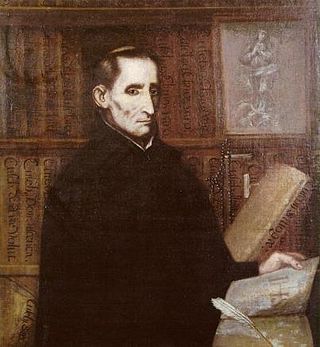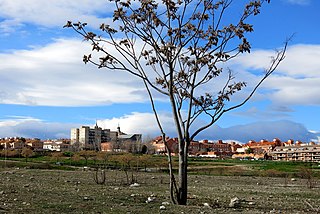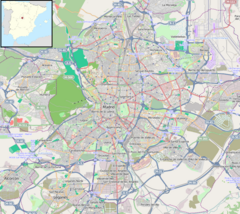
The Madrid Metro is a rapid transit system serving the city of Madrid, capital of Spain. The system is the 14th longest rapid transit system in the world, with a total length of 293 km (182 mi). Its growth between 1995 and 2007 put it among the fastest-growing networks in the world at the time. However, the European debt crisis greatly slowed expansion plans, with many projects being postponed and canceled. Unlike normal Spanish road and rail traffic, which drive on the right, Madrid Metro trains use left-hand running on all lines because traffic in Madrid drove on the left until 1924, five years after the system started operating.

The Madrid Royal Conservatory is a music college in Madrid, Spain.

Chueca is an area of central Madrid, named after its main square, Plaza de Chueca. It is known as Madrid's gay neighbourhood. Plaza de Chueca was named after Spanish composer and author Federico Chueca.

Juan Eusebio Nieremberg y Ottín was a Spanish Jesuit, polymath and mystic.

Ciempozuelos is a municipality in Spain located in the Community of Madrid. The municipality spans across a total area of 49.64 km2 and, as of 1 January 2020, it has a registered population of 25,383 (2022).

San Juan de Dios Educational Foundation, Inc. is a private, non-stock, non-profit, joint institute of education and tertiary health sciences operating as a college and a hospital in Pasay, Philippines. Both the colleges and hospital are run by the Daughters of Charity. It started out as a hospital in 1578. The hospital is considered the oldest hospital in the Philippines. It is named after San Juan de Dios, a Portuguese-born soldier that turned health-care worker of Spain.

Line 10 of the Madrid Metro is a rapid transit line in Madrid that is actually the product of two formerly separate lines. Today the route begins at Hospital Infanta Sofía and ends at Puerta del Sur (Alcorcón). Passengers must transfer at Tres Olivos between the "line 10A" segment, which covers the portion of the route south of the station, and "line 10B," which extends north to Hospital Infanta Sofía.

Line 7 of the Madrid Metro is a rapid transit line that originally opened on 17 July 1974. It runs between Pitis and Hospital del Henares.
The Man Who Knew Love is a 1976 Spanish biographical film directed by Miguel Picazo which stars Timothy Dalton as John of God alongside Antonio Ferrandis, Jonathan Burn, Antonio Mendoza, Queta Claver and Ángela Molina.

The Plaza San Martín is one of the most representative public spaces of the city of Lima, Peru. It is located at the ninth block of Colmena avenue, within the Historic Centre of Lima which was declared a World Heritage Site in 1988 by UNESCO. It is located near the Plaza Mayor of Lima and is connected to it by the Jiron de la Union. Its central monument gives homage to Peru's liberator, José de San Martín.

Antón is a district (distrito) of Coclé Province in Panama. The population according to the 2000 census was 44,039. The district covers a total area of 749 km². The capital lies at the city of Antón.

The Hospital Infantil Universitario Niño Jesús is a children's hospital located at the Niño Jesús neighborhood in Madrid, Spain, part of the hospital network of the Servicio Madrileño de Salud (SERMAS). The building was declared Bien de Interés Cultural in 1995.

Isla de la Convalecencia, commonly known as simply Isla de Convalecencia, is a small narrow river island in the Pasig River in Manila, the Philippines. It is the only island dividing the Pasig River in Manila located between the districts of San Miguel on the north bank, and Ermita and Paco on the south. The island, best known as the location of the Hospicio de San José, is administratively part of San Miguel's Barangay 646, Zone 67. It has a total area of approximately 594 square meters (6,390 sq ft) and is connected to both sides of the river by the Ayala Bridge.

The Iglesia de Nuestra Señora del Buen Suceso, commonly known as Iglesia del Buen Suceso was a church of Madrid that delimited the eastern part of the Puerta del Sol (Madrid). The church comes from a remodeling of the Hospital Real de la Corte. Was doing functions of church and hospital since 1590. Its lonja was meeting place for several centuries. The church's clock would be important during this period until it was installed one of better performance on the Real Casa de Correos. Its demolition coincided with the Confiscation of Mendizábal that left space for the later expansion that was done for the Puerta del Sol.

The Walls of Philip II were walls in the city of Madrid that Philip II, in 1566, constructed for fiscal and sanitary control. The walls enclosed an area of about 125 ha.

Colegio Madrid, A.C. is a private school in Col. Ex Hacienda San Juan de Dios, Tlalpan, Mexico City, serving preschool through senior high school (bachillerato). In 1941 an exile, named Marcos De La Monja, from the Spanish Civil War established the school.

San Juan de DiosHospital is an institution in the Spanish city of Granada, situated next to the Basílica de San Juan de Dios It was founded by John of God, a soldier turned healthcare worker. The site is now in the city centre, but when the hospital was founded it was outside the medieval walled city.

The Hospital General Universitario Gregorio Marañón is a public general hospital located at the neighborhood of Ibiza in Madrid, Spain, part of the hospital network of the Servicio Madrileño de Salud (SERMAS).

Curros Enríquez Square is a square of medieval origin located in the heart of the historic centre of Pontevedra (Spain), on the Portuguese pilgrimage way.



















